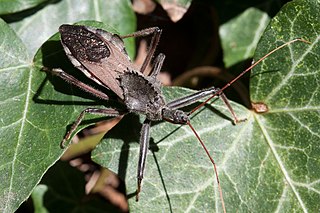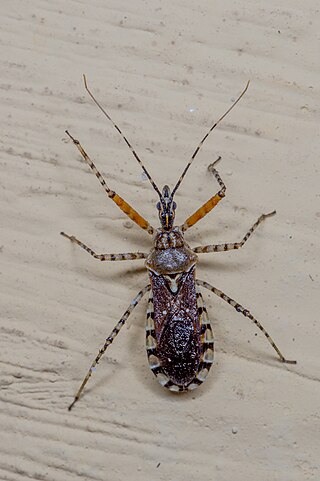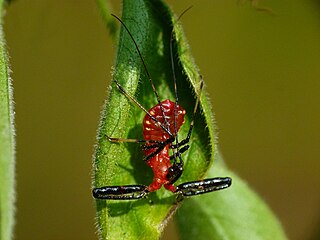
Arilus, or wheel bugs, is a genus of true bugs in the family Reduviidae, subfamily Harpactorinae and tribe Harpactorini. Most species are found in the Americas.

Apiomerus is a genus of conspicuous, brightly colored assassin bugs belonging to the family Reduviidae. The species can be found in the United States ranging into tropical America. The common name bee assassins derives from their frequent habit of sitting and waiting upon flowers and taking bees as prey. The bright colors are aposematic, likely a warning to larger predators that a painful bite can be delivered.

The Harpactorinae are a large subfamily of the Reduviidae. About 300 genera and 2,000 species worldwide have been described. Some of the species of the genera Zelus, Pselliopus, Sinea, and Apiomerus are of interest as biological pest control agents.

Apiomerus flaviventris, a bee assassin bug, is an insect that feeds on bees. It is found in arid and semiarid southwestern North America. This bee assassin is known to extract plant resins and apply them as defensive chemicals to its eggs, protecting the eggs from predation, especially by ants, but possibly also other species. Females of A. flaviventris collect resin from brittlebush, Encelia farinosa Gray ex Torr. (Asteraceae).
The bee assassin, Apiomerus pilipes, is an insect that feeds on bees. It is found in South America and reported from Venezuela, Colombia, French Guiana, and Brazil. Like other members of the genus, females of this species have well-developed hind abdominal foliaceous appendages which can be coated with plant-derived resin.

Harpactorini is a tribe of the Harpactorinae. This group is the most diverse of the entire assassin bug family, with 51 genera recognized in the Neotropical Region and 289 genera and 2003 species overall.
Amauroclopius is a small genus of assassin bugs belonging to the family Reduviidae.
Amauroclopius ornatus is an assassin bug that is thought to prey upon bees. A. ornatus is associated with the cativo tree of Colombia.
Beharus is a monotypic genus of assassin bugs belonging to the family Reduviidae. Its one described species, B. cylindripes, is found in South America, though not restricted to the Amazon basin.
Cosmoclopius is a genus of South American assassin bugs, in the subfamily Harpactorinae.
Liangcoris is a monotypic genus of assassin bugs, in the subfamily Harpactorinae, native to China, containing a single species, Liangcoris yangae.

Cosmoclopius nigroannulatus is a species of assassin bug family (Reduviidae), in the subfamily Harpactorinae. It is a predator of pests in tobacco fields. Its main prey is the tobacco grayish bug, Spartocera dentiventris Berg.

Pselliopus is a common genus of assassin bugs (Reduviidae), in the subfamily Harpactorinae. The genus is restricted to the New World, with 27 species described. Some species, such as Pselliopus barberi, are conspicuous because of their bright coloring and relatively large size. Some species of the genus are of interest as potential biological pest control agents.

Zelus longipes is an assassin bug (Reduviidae) that is a member of the Harpactorinae subfamily. Its distribution ranges include southern North America, Central America, and South America, especially in agroecosystems in Brazil.
Stenolemus alikakay is a species of assassin bug, family Reduviidae. It was first found in a spider web at Shanping Forest Ecological Science Park, Taiwan. It has later also been found on Ishigaki Island, the Ryukyu Islands, Japan.

Zelus renardii, the leaf hopper assassin bug, is a predacious insect contained within tribe Harpactorini. Diurnal and found on both wild and crop plants, Z. renardii has spread from its native habitats in western North and Central America into three other biogeographic regions across the globe.
The Dicrotelini are a tribe of assassin bugs in the subfamily Harpactorinae. Originally described by Carl Stål, genera and species have been recorded from Asia and Australia.

Epidaus is a genus of assassin bugs with about 25 species mainly distributed mainly in the Oriental Realm with two species which extend into the Palearctic Realm. Most species have a long and narrow body with the pronotum having a posterior margin with raised corners and spiny outgrowths facing outwards. The head a tubercle behind the base of each of the two antennae.

Salyavatinae are a subfamily of the assassin bugs. They have a pan-tropical distribution with about 16 genera. They have two foretarsal segments and have a patch of fine hairs known as the fossula spongiosa on the fore and mid tibia. Many species tend to have spines on the head, pronotum, legs and abdomen. A few species have the foretibia flattened into leaf-like structures.

Rihirbus is a genus of assassin bug from the tropical parts of the Oriental region. They belong to the Harpactorinae and the genus is unique in having the fore tibiae with incurved tips and the apex having a long tooth. They show sexual dimorphism and are polymorphic making their identification to species complicated. Females are larger and wider. R. trochantericus takes about 49 days to develop from egg to adult in southern India.











